IIBA vs IREB.pdf
0 likes260 views
Prezentacja z webinaru IIBA Poland Chapter i IREB. Agnieszka Balcerzak Karolina Zmitrowicz
1 of 8
Download to read offline
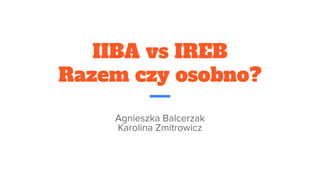
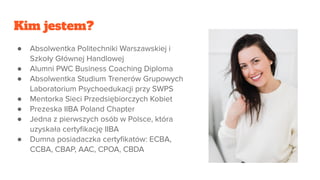

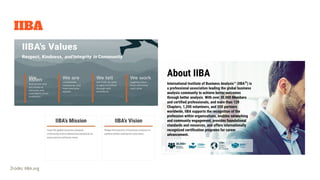
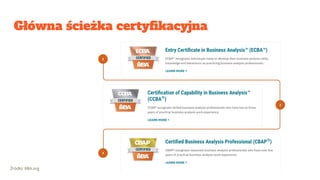

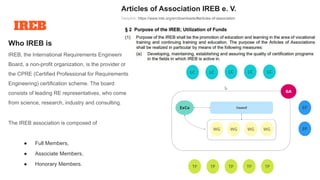

Ad
Recommended
HowToWriteGoodRequirements.pdf
HowToWriteGoodRequirements.pdfKAROLINA ZMITROWICZ
╠²
This document discusses the importance of writing good requirements in project management, detailing quality characteristics and criteria for effective requirements. It provides examples of poor requirements and offers strategies for improving them, such as using templates and adhering to established standards. Additionally, it emphasizes the significance of avoiding redundancy, inconsistency, and ensuring proper structure in work products.Zmitrowicz IT Stacja UX
Zmitrowicz IT Stacja UXKAROLINA ZMITROWICZ
╠²
Warsztat realizowany przy współpracy SJSI i Stacja IT. UX a analiza.Zmitrowicz Test Strategy Test Forum Milan 2019
Zmitrowicz Test Strategy Test Forum Milan 2019KAROLINA ZMITROWICZ
╠²
The document outlines the process of building a test strategy, detailing its essential components such as context, stakeholders, goals, and the various activities involved in testing. It emphasizes the importance of tests in achieving organizational objectives and includes references to numerous testing artifacts and standards. Additionally, it provides a structure for managing testing processes, including risk analysis, test planning, and evaluation metrics.Zmitrowicz SQA DAYS EU Riga
Zmitrowicz SQA DAYS EU RigaKAROLINA ZMITROWICZ
╠²
The document discusses improving testing organizations through adopting the Test Maturity Model Integration (TMMI). It notes that organizations often struggle with issues like poor communication, lack of work standards, and quality problems. The TMMI model provides a structured framework of process areas and practices that can help build an effective testing approach. The case study describes how one organization used TMMI at levels 2-4 to implement tools like Confluence and JIRA, establish a knowledge base, and define requirements, test cases, and reporting processes. Adopting the TMMI model helped solve their challenges and build better quality.Modern BA_Analyst days 2017
Modern BA_Analyst days 2017KAROLINA ZMITROWICZ
╠²
The document discusses the evolving role of business analysts (BAs) in the context of agile methodologies and digital transformation, highlighting the need for a multidisciplinary approach and the integration of various competencies. It critiques traditional BAsŌĆÖ responsibilities and emphasizes the importance of delivering value, adapting to market expectations, and overcoming challenges in communication between business and technology. The piece underscores the shift towards a more agile, rapid developmental process that enhances team dynamics and stakeholder engagement.Quality Management in Agile world_SQA Days 2017
Quality Management in Agile world_SQA Days 2017KAROLINA ZMITROWICZ
╠²
The document discusses the transformation of quality management in the context of agile methodologies, highlighting the challenges of integrating traditional quality management approaches with agile practices. It outlines issues related to project scope, work efficiency, and communication within agile teams, and suggests that quality management and agile can coexist effectively. The author emphasizes the importance of a modern quality management strategy that supports a multidisciplinary and value-driven process.Traceability - ways to ensure better management and consistency_HUSTEF
Traceability - ways to ensure better management and consistency_HUSTEFKAROLINA ZMITROWICZ
╠²
The document discusses the importance of traceability in managing complexity within projects, emphasizing the need for understanding information requirements, relationships between artifacts, and proper structuring. It highlights various aspects such as change impact analysis, coverage analysis, and the maintenance of traceability over time. The key to effective traceability lies in aligning business goals, requirements, and test cases throughout the project lifecycle.Requirements quality in agile_FTD 2018
Requirements quality in agile_FTD 2018KAROLINA ZMITROWICZ
╠²
The document discusses quality assurance for requirements in agile projects. It covers characteristics of good user stories, acceptance criteria, and quality gates. User stories should follow INVEST criteria - be independent, negotiable, valuable, estimable, small, and testable. Acceptance criteria and scenarios define when a story is complete. Quality gates ensure requirements and stories meet definitions of ready and done before development and release. Reviews like backlog grooming and three amigos meetings aid quality.Sjsi sztuka modelowania
Sjsi sztuka modelowaniaKAROLINA ZMITROWICZ
╠²
About modeling, good modeling and methods of modeling allowing to ensure complete, consistend and usable information model. Presented originally at http://requirements.org.pl/seminaria2017/modelarskie.htmlZarzadzanie jakoscia_Akademia jakosci2017
Zarzadzanie jakoscia_Akademia jakosci2017 KAROLINA ZMITROWICZ
╠²
Kilka s┼é├│w o zarz─ģdzaniu jako┼øci─ģ - od planowania, po optymalizacj─Ö/Few information about quality management - starting from planning, to optimization. Simple Ways of Planning, Designing and Testing Usability of a Software Produc...
Simple Ways of Planning, Designing and Testing Usability of a Software Produc...KAROLINA ZMITROWICZ
╠²
The document discusses the importance of usability in software design, emphasizing that a product must be user-friendly to be effective. It outlines strategies for planning, designing, and testing usability, including user involvement and iterative design methods. Additionally, it highlights the significance of understanding user needs and measuring usability through various methods and tools.Analiza wpływu_TestingCup 2016
Analiza wpływu_TestingCup 2016KAROLINA ZMITROWICZ
╠²
Short introduction to impact analysis and traceabilityAnaliza wpływu - beIT
Analiza wpływu - beITKAROLINA ZMITROWICZ
╠²
Analiza wp┼éywu oraz metody zapewnienia sp├│jno┼øci specyfikacji i modeli UML.
Konferencja be IT, ┼øcie┼╝ka be Analyst
Karolina Zmitrowicz Hanna Wesołowska
DonŌĆÖt just test Usability ŌĆō build it!
DonŌĆÖt just test Usability ŌĆō build it! KAROLINA ZMITROWICZ
╠²
The document discusses the importance of usability engineering and designing for usability from the beginning. It provides definitions of usability and outlines the key steps in the usability engineering process, including concept planning, understanding needs, requirements analysis, and design/development. Throughout each step, it emphasizes applying best practices like user research, prototyping, and usability testing to prevent usability problems and ensure products are easy to use.Business awareness of testers and the quality of testing
Business awareness of testers and the quality of testing KAROLINA ZMITROWICZ
╠²
The document discusses the essential skills needed to be an effective tester, emphasizing the importance of both technical knowledge and soft skills, such as communication and negotiation. It highlights the necessity for testers to understand business requirements, as poorly documented or inconsistent requirements can lead to costly errors in software development. Solutions include collaborating with business analysts and involving customers in the testing process to ensure the development of the right product.W poszukiwaniu źródeł problemów
w projektach IT
W poszukiwaniu źródeł problemów
w projektach ITKAROLINA ZMITROWICZ
╠²
CareerCon "Tester's career" April 2013 (Wroclaw)Minimize the project risk - build good business requirements
Minimize the project risk - build good business requirementsKAROLINA ZMITROWICZ
╠²
The document discusses the importance of writing good business requirements for minimizing project risk. It notes that the real problems with many IT projects stem from a lack of proper analysis and preparation, with requirements often not clearly defined or tied to business goals and values. The document provides guidance on best practices for writing business requirements, including quantifying requirements, focusing on stakeholder needs and system qualities rather than just functions, ensuring "rich specification" that provides important background context for each requirement, and carrying out quality control checks of requirements.More Related Content
More from KAROLINA ZMITROWICZ (9)
Sjsi sztuka modelowania
Sjsi sztuka modelowaniaKAROLINA ZMITROWICZ
╠²
About modeling, good modeling and methods of modeling allowing to ensure complete, consistend and usable information model. Presented originally at http://requirements.org.pl/seminaria2017/modelarskie.htmlZarzadzanie jakoscia_Akademia jakosci2017
Zarzadzanie jakoscia_Akademia jakosci2017 KAROLINA ZMITROWICZ
╠²
Kilka s┼é├│w o zarz─ģdzaniu jako┼øci─ģ - od planowania, po optymalizacj─Ö/Few information about quality management - starting from planning, to optimization. Simple Ways of Planning, Designing and Testing Usability of a Software Produc...
Simple Ways of Planning, Designing and Testing Usability of a Software Produc...KAROLINA ZMITROWICZ
╠²
The document discusses the importance of usability in software design, emphasizing that a product must be user-friendly to be effective. It outlines strategies for planning, designing, and testing usability, including user involvement and iterative design methods. Additionally, it highlights the significance of understanding user needs and measuring usability through various methods and tools.Analiza wpływu_TestingCup 2016
Analiza wpływu_TestingCup 2016KAROLINA ZMITROWICZ
╠²
Short introduction to impact analysis and traceabilityAnaliza wpływu - beIT
Analiza wpływu - beITKAROLINA ZMITROWICZ
╠²
Analiza wp┼éywu oraz metody zapewnienia sp├│jno┼øci specyfikacji i modeli UML.
Konferencja be IT, ┼øcie┼╝ka be Analyst
Karolina Zmitrowicz Hanna Wesołowska
DonŌĆÖt just test Usability ŌĆō build it!
DonŌĆÖt just test Usability ŌĆō build it! KAROLINA ZMITROWICZ
╠²
The document discusses the importance of usability engineering and designing for usability from the beginning. It provides definitions of usability and outlines the key steps in the usability engineering process, including concept planning, understanding needs, requirements analysis, and design/development. Throughout each step, it emphasizes applying best practices like user research, prototyping, and usability testing to prevent usability problems and ensure products are easy to use.Business awareness of testers and the quality of testing
Business awareness of testers and the quality of testing KAROLINA ZMITROWICZ
╠²
The document discusses the essential skills needed to be an effective tester, emphasizing the importance of both technical knowledge and soft skills, such as communication and negotiation. It highlights the necessity for testers to understand business requirements, as poorly documented or inconsistent requirements can lead to costly errors in software development. Solutions include collaborating with business analysts and involving customers in the testing process to ensure the development of the right product.W poszukiwaniu źródeł problemów
w projektach IT
W poszukiwaniu źródeł problemów
w projektach ITKAROLINA ZMITROWICZ
╠²
CareerCon "Tester's career" April 2013 (Wroclaw)Minimize the project risk - build good business requirements
Minimize the project risk - build good business requirementsKAROLINA ZMITROWICZ
╠²
The document discusses the importance of writing good business requirements for minimizing project risk. It notes that the real problems with many IT projects stem from a lack of proper analysis and preparation, with requirements often not clearly defined or tied to business goals and values. The document provides guidance on best practices for writing business requirements, including quantifying requirements, focusing on stakeholder needs and system qualities rather than just functions, ensuring "rich specification" that provides important background context for each requirement, and carrying out quality control checks of requirements.Simple Ways of Planning, Designing and Testing Usability of a Software Produc...
Simple Ways of Planning, Designing and Testing Usability of a Software Produc...KAROLINA ZMITROWICZ
╠²
IIBA vs IREB.pdf
- 1. IIBA vs IREB Razem czy osobno? Agnieszka Balcerzak Karolina Zmitrowicz
- 2. Kim jestem? ŌŚÅ Absolwentka Politechniki Warszawskiej i Szko┼éy G┼é├│wnej Handlowej ŌŚÅ Alumni PWC Business Coaching Diploma ŌŚÅ Absolwentka Studium Trener├│w Grupowych Laboratorium Psychoedukacji przy SWPS ŌŚÅ Mentorka Sieci Przedsi─Öbiorczych Kobiet ŌŚÅ Prezeska IIBA Poland Chapter ŌŚÅ Jedna z pierwszych os├│b w Polsce, kt├│ra uzyska┼éa certy’¼ükacj─Ö IIBA ŌŚÅ Dumna posiadaczka certy’¼ükat├│w: ECBA, CCBA, CBAP, AAC, CPOA, CBDA
- 3. Kim jestem? ŌŚÅ Absolwentka ZUT ŌŚÅ Analityk biznesowy i mened┼╝er jako┼øci z zawodu i zami┼éowania ŌŚÅ Wyk┼éadowca akademicki ŌŚÅ Autorka kilku ksi─ģ┼╝ek i licznych publikacji ŌŚÅ Obecna funkcja: cz┼éonek zarz─ģdu IREB (International Requirements Engineering Board) ŌŚÅ Pe┼éni┼éa funkcje: ŌŚŗ Prezes zarz─ģdu SJSI ŌŚŗ Prezes zarz─ģdu ISTQB ŌŚŗ Lider grup roboczych IREB oraz TMMi w SJSI ŌŚŗ Cz┼éonek grup roboczych w Ministerstwie Cyfryzacji
- 5. G┼é├│wna ┼øcie┼╝ka certy’¼ükacyjna ┼╣r├│d┼éo: IIBA.org
- 7. IREB Who IREB is IREB, the International Requirements Engineering Board, a non-profit organization, is the provider of the CPRE (Certified Professional for Requirements Engineering) certification scheme. The board consists of leading RE representatives, who come from science, research, industry and consulting. The IREB association is composed of ŌŚÅ Full Members, ŌŚÅ Associate Members, ŌŚÅ Honorary Members. Articles of Association IREB e. V. Deeplink: https://www.ireb.org/en/downloads/#articles-of-association
- 8. ┼Ücie┼╝ki certy’¼ükacyjne IREB ┼╣r├│d┼éo: https://www.ireb.org/en/cpre/basics/
